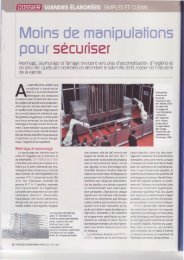FRANCOIS DEUMIER* writes in this first of a two part series ... - Lutetia
FRANCOIS DEUMIER* writes in this first of a two part series ... - Lutetia
FRANCOIS DEUMIER* writes in this first of a two part series ... - Lutetia
Create successful ePaper yourself
Turn your PDF publications into a flip-book with our unique Google optimized e-Paper software.
Picture 2<br />
MALAXEUR 1<br />
2l mbar<br />
0 mbar<br />
{ to be protected, we should advise to<br />
turn slowly and to limit the number<br />
<strong>of</strong> turns. Thus, one will rather<br />
recommend 1000 to 1800 turns for<br />
a superior ham aga<strong>in</strong>st 4000 for a<br />
basic high-yield ham, <strong>in</strong> the section<br />
<strong>of</strong> which the muscle fibre will not be<br />
even recognizable any more. Vacuum<br />
also makes meat denser dur<strong>in</strong>g<br />
massag<strong>in</strong>g, which helps mechanical<br />
work,<br />
For the most fragile products, it<br />
is possible to work with a pendular<br />
mode massag<strong>in</strong>g by mak<strong>in</strong>g cycles<br />
<strong>of</strong> 75o/<strong>of</strong> a turn towards and<br />
ttaen 75o/<strong>of</strong> a turn forwards, thus<br />
prevent<strong>in</strong>g the product from fall<strong>in</strong>g.<br />
Mass transfers dur<strong>in</strong>g massag<strong>in</strong>g<br />
Diffusion mechanisms<br />
Ingredient diffusion phenomena<br />
<strong>in</strong> the meat are slow. Moreover,<br />
heterogeneity <strong>of</strong> the meat is an<br />
important limit<strong>in</strong>g factor, s<strong>in</strong>ce<br />
mass transfers are slowed down by<br />
connective tissue and fat. Ingredient<br />
migration is fastest when parallel to<br />
the direction <strong>of</strong> muscle fibres and<br />
slowest when perpendicular, mak<strong>in</strong>g<br />
meat an anisotropic medium. Dur<strong>in</strong>g<br />
massag<strong>in</strong>g and accord<strong>in</strong>g to the<br />
process parameters, a more or less<br />
important destructuration <strong>of</strong> meat<br />
tissues is reached and it <strong>in</strong>fluences<br />
the physical properties <strong>of</strong> the meat.<br />
Hvdrodvnamic mechanisms<br />
Many foods have a natural porosity<br />
which can be high (e.g. apple) or<br />
low (e.g. meat). Meat porosity is<br />
the consequence <strong>of</strong> the presence <strong>of</strong><br />
PROGRAMME 41 test<br />
NUMERO DE LOT XXXX<br />
TEMPSRESTANT 0h Sm<strong>in</strong><br />
SECTION 4 0h Sm<strong>in</strong><br />
PHASE 3 0m<strong>in</strong>10<br />
I<br />
I<br />
FONCTIONS<br />
Rot"tion<br />
Ma"ns.<br />
f vo"<br />
f vo" tirite<br />
I vide poumon<br />
o<br />
I Bouilleur<br />
f vapeur<br />
! cnaua<br />
! Frold<br />
SORTIES<br />
I Rot"tion<br />
I vo.ng"<br />
I Rorp"<br />
Oeorp.,<br />
Oeorp.,<br />
(| Bouilleur<br />
I wv"p, ,t<br />
O EV sé.. 'ité<br />
(| ctrauo<br />
f nroyc,t<br />
fgEpsj!!ryglulg vap€ur 3270 aêc<br />
deslLe.gggvc!!.9s- sécurtté 3420 sec<br />
The massager allows salt<strong>in</strong>g and pickl<strong>in</strong>g <strong>of</strong><br />
most meat products.<br />
<strong>in</strong>tramuscular and <strong>in</strong>termuscular<br />
spaces and arterial and venous<br />
systems.<br />
This porosity depends on the<br />
pressure and on meat elasticity.<br />
When meat is soaked <strong>in</strong> br<strong>in</strong>e<br />
dur<strong>in</strong>g massag<strong>in</strong>g, meat degasses<br />
when pressure decreases and<br />
aspires br<strong>in</strong>e <strong>in</strong> its pores when<br />
atmospheric pressure is recovered.<br />
These hydrodynamic mechanisms<br />
<strong>in</strong>duce an <strong>in</strong>filtration <strong>of</strong> br<strong>in</strong>e <strong>in</strong><br />
meat structure and thus <strong>in</strong>crease the<br />
exchange surface between meat and<br />
br<strong>in</strong>e.<br />
Prote<strong>in</strong> extraction dur<strong>in</strong>g massag<strong>in</strong>g<br />
Until approximately 40gl<br />
kg, sodium chloride solubilises<br />
myolibrillar prote<strong>in</strong>s by <strong>in</strong>creas<strong>in</strong>g<br />
ionic strength. Beyond, prote<strong>in</strong>s<br />
are denatured. Phosphates also<br />
contribute to a better solubilisation<br />
<strong>of</strong> prote<strong>in</strong>s. Indeed, they complex<br />
t}ire Ca2+ ions and thus break<br />
the Ca-bridges between act<strong>in</strong> and<br />
myos<strong>in</strong>. By un-bridg<strong>in</strong>g acto-myos<strong>in</strong>,<br />
phosphates <strong>in</strong>crease solubility <strong>of</strong><br />
muscular prote<strong>in</strong>s.<br />
Dur<strong>in</strong>g massag<strong>in</strong>g, salt and the<br />
phosphates solubilise prote<strong>in</strong>s which<br />
migrate to muscles surface and<br />
which form a'silt'with meat and<br />
fibre fragments, water, <strong>in</strong>gredients<br />
and fat. Thanks to its emulsify<strong>in</strong>g<br />
properties, <strong>this</strong> 'silt' is essential to<br />
ensure the cohesion <strong>of</strong> the sous-vide<br />
cooked products, reconstituted from<br />
various muscles, as cooked pork<br />
ham, cooked beef ham or poultrybased<br />
cooked products. It also allows<br />
a better b<strong>in</strong>d<strong>in</strong>g <strong>of</strong> meat to the batter<br />
for breaded products.<br />
Prote<strong>in</strong> extraction is enhanced<br />
by the vacuum, which allows<br />
elim<strong>in</strong>at<strong>in</strong>g air bubbles, It also<br />
<strong>in</strong>creases with temperature. It is<br />
better to work between 6-8'C than<br />
around OoC to optimize prote<strong>in</strong><br />
extraction.<br />
Ideal silt presents a prote<strong>in</strong> content<br />
<strong>of</strong> approximately 10o/o. It is clearly<br />
visible and sticks.<br />
Products stabilization dur<strong>in</strong>g massag<strong>in</strong>g<br />
Vacuum massag<strong>in</strong>g also allows<br />
limit<strong>in</strong>g the development <strong>of</strong><br />
alteration aerobic flora, especially<br />
as the temperature is controlled<br />
throughout the massag<strong>in</strong>g (cooled<br />
double-jacket).<br />
With high rotat<strong>in</strong>g speeds,<br />
the product undergoes a<br />
mechanical heat<strong>in</strong>g prejudicial<br />
to its microbiological quality.<br />
However, after a massag<strong>in</strong>g at high<br />
temperature (more than I2"C),<br />
one may observe small holes <strong>in</strong> the<br />
cooked products.<br />
It is then advisable to make<br />
The processed products can be salted,<br />
cured, mar<strong>in</strong>ated or mar<strong>in</strong>ated and coated.<br />
They can be <strong>in</strong>tended thereafter to be<br />
marketed <strong>in</strong> the state.<br />
AM:PM - May/une 2011






